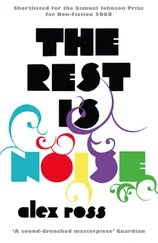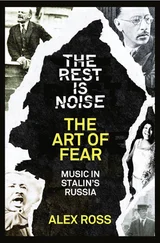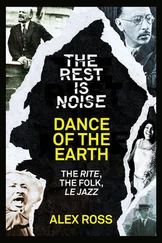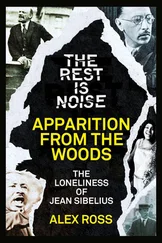This is a chapter from Alex Ross’s groundbreaking history of 20 thcentury classical music, The Rest is Noise .
It is released as a special stand-alone ebook to celebrate a year-long festival at the Southbank Centre, inspired by the book. The festival consists of a series of themed concerts. Read this chapter if you’re attending concerts in the episodes
Politics and Spirituality in the Late Twentieth Century and Superpower! Hollywood, Minimalism and Experiments in Sound
Alex Ross, music critic for the New Yorker , is the recipient of numerous awards for his work, including an Arts and Letters Award from the American Academy of Arts and Letters, the Belmont Prize in Germany and a MacArthur Fellowship. The Rest is Noise was his first book and garnered huge critical acclaim and a number of awards, including the Guardian First Book Award and the National Book Critics Circle Award. He is also the author of Listen to This .
BEETHOVEN WAS WRONG
Bop, Rock, and the Minimalists
From The Rest Is Noise by Alex Ross

Contents
Beethoven Was Wrong
Notes
Suggested Listening and Reading
Copyright
About the Publisher
14
BEETHOVEN WAS WRONG
Bop, Rock, and the Minimalists
One night in 1967, György Ligeti was sitting with several colleagues at the Darmstadt Schlosskeller, the favorite late-night hangout of teachers and students at the Summer Courses for New Music, when Sgt. Pepper’s Lonely Hearts Club Band, a new album by the Beatles, started playing over the loudspeakers. Some of the sounds on the record bore a surprising resemblance to the Darmstadters’ latest and most advanced experiments. The song “A Day in the Life” included two spells of ad libitum playing, the second of them leading into a gorgeously strange E-major chord played by three pianos and a harmonium. Players were given a score indicating what register they should have reached in any given bar. The last chord was executed in musique concrète fashion, the attack cut off and the decay amplified over a long duration.
The Beatles had first dipped into the Darmstadt sound in March of the previous year, while working on the album Revolver. Paul McCartney had been checking out Stockhausen’s Gesang der Jünglinge, with its electronic layering of voices, and Kontakte, with its swirling tape-loop patterns. At his request, engineers at Abbey Road Studios inserted similar effects into the song “Tomorrow Never Knows.” By way of thanks, the Beatles put Stockhausen’s face on the cover of Sgt. Pepper’s Lonely Hearts Club Band, in and among cutout pictures of other mavericks and countercultural heroes. The following year, for the White Album, John Lennon and Yoko Ono created the tape collage “Revolution 9,” where, for a split second, the final chords of Sibelius’s Seventh Symphony can be heard. Adventurous rock bands on the West Coast also paid heed to the classical avant-garde. Members of both the Grateful Dead and Jefferson Airplane attended Stockhausen’s lectures in Los Angeles in 1966 and 1967, while the maverick rock star Frank Zappa spoke of his teenage love for the music of Edgard Varèse, whom he once looked up in the phone book and called out of the blue.
Even the most jaded veteran of twentieth-century musical upheaval must have been startled to find that the postwar avant-garde was now serving as mood music for the psychedelic generation. The wall separating classical music from neighboring genres appeared ready to crumble, as it had momentarily in the twenties and thirties, when Copland, Gershwin, and Ellington crossed paths at Carnegie Hall. Classical record labels made amusing attempts to capitalize on the phenomenon by marketing abstruse modern repertory to kids on LSD. An LP of Bengt Hambraeus’s Constellations II and Interferences on the Limelight label carried this text on the jacket: “Listening to Bengt Hambraeus’s fantastic sound—it’s [sic] magnificent electronic and organ-organized electronic total sound experience should involve you as much as any music that you are capable of loving … be it the sound of The Beatles, Bach, Beethoven, Boulez, Beach Boys, or Belefonte [sic], Barbra Streisand, Pearl Bailey, Blue Cheer, or whatever. Hambraeus is really tuned in. Smashing!”
Even as Stockhausen and Ligeti brushed against the counterculture, several younger Americans—Terry Riley, Steve Reich, and Philip Glass—made a different kind of breakthrough. They simplified their harmonic language and rediscovered the pleasure of a steady pulse, devising a modern tonality that had nothing nostalgic about it. What Weill said in the twenties held true again: “Once musicians obtained everything they had imagined in their most daring dreams, they started again from scratch.”
Riley, Reich, and Glass came to be called minimalists, although they are better understood as the continuation of a circuitous, difficult-to-name development in American music that dated back to the early years of the century, and more often than not took root on the West Coast. This alternative canon includes Henry Cowell and Lou Harrison, who drew on non-Western traditions and built up a hypnotic atmosphere through insistent repetition; Morton Feldman, who distributed minimal parcels of sound over long durations; and La Monte Young, who made music from long, buzzing drones. All of them in one way or another set aside a premise that had governed classical composition for centuries—the conception of a musical work as a self-contained linguistic activity that develops relationships among discrete thematic characters over a well-marked period of time. This music was, by contrast, open-ended, potentially limitless.
It was a purely American art, free of modernist anxiety and inflected with pop optimism. Reich said: “Schoenberg gives a very honest musical portrayal of his times. I salute him—but I don’t want to write like him. Stockhausen, Berio, and Boulez were portraying in very honest terms what it was like to pick up the pieces of a bombed-out continent after World War II. But for some American in 1948 or 1958 or 1968—in the real context of tail fins, Chuck Berry, and millions of burgers sold—to pretend that instead we’re really going to have the dark-brown Angst of Vienna is a lie, a musical lie …” Reich and his colleagues borrowed from popular music, especially from bebop and modern jazz, and they affected pop music in turn. The Velvet Underground adopted Young’s drone aesthetic. Art rockers such as David Bowie and Brian Eno showed up at Reich’s and Glass’s shows. Minimalist influence radiated outward in the eighties and nineties, to the point where you could walk into any hip boutique or hotel lounge and sooner or later hear some distant, burbling cousin of Reich’s Music for 18 Musicians.
Eno once summarized minimalism as “a drift away from narrative and towards landscape, from performed event to sonic space.” Riley, Reich, and Glass spent their formative years in the urban wilds of New York and San Francisco, but their works have spiritual links to the capacious West. Unlike Copland’s sepia-toned prairie, minimalist vistas are filtered through new ways of seeing and hearing that relate to the technology of speed. They evoke the experience of driving in a car across empty desert, the layered repetitions in the music mirroring the changes that the eye perceives—road signs flashing by, a mountain range shifting on the horizon, a pedal point of asphalt underneath.
Читать дальше













